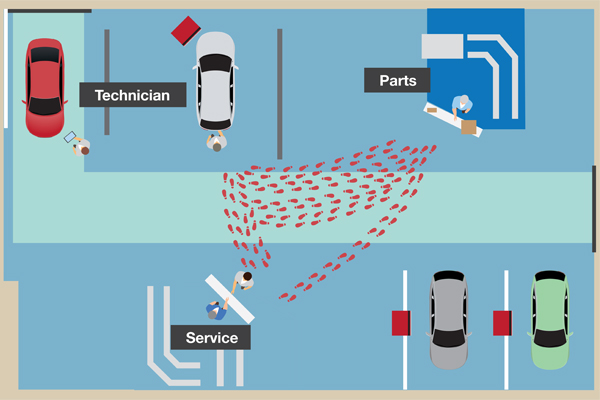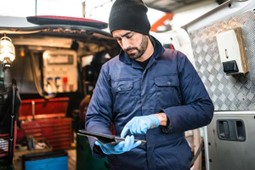Is “Walking” a Hidden Revenue Leak in Your Service Department?

Article Highlights:
- You might have a big revenue leak in your service drive.
- Walking is a red flag.
I’m a walker.
Sometimes I walk slowly – a “wander and ponder” as I like to say. Those walks are for when I have a problem I’m trying to work out.
Other times I walk at a normal speed. That’s for when I need a quick break from my desk to clear my head.
There’s a route I take that’s perfect for this, and as a data guy, I know:
• It’s almost exactly 1.2 kilometers
• At normal speed, I walk the circuit in just under 15 minutes, which is about 5 kilometers per hour.
I tell you this not to encourage you to take occasional afternoon strolls, but to illustrate something about walking.
Depending on which study you read, 5-6 kilometers per hour is the average walking speed for most people. (The current Wikipedia article about walking has it at 3.1 MPH.)
That 5 kph number is important, because there’s a LOT of walking that happens every day in service.
Some walking is necessary and productive; some of it is wasteful.
Is Walking is Hurting Your Revenue?
If you’ll pardon the pun, today I want to “walk” you through your own service department.
Here’s what you’ll need:
1. A blank sheet of paper.
2. A pen.
3. A rough understanding of how jobs flow through your service department.
Ready to go? Let’s get walking…
Step 1: Draw Your Shop
On your paper, do a rough sketch of your shop. You’ll need to label these areas specifically:
• The drive, with the direction of traffic noted.
• Advisors’ desk.
• Service bays.
• Parts desk.
Step 2: Trace a Typical RO Through Your Shop
On your paper, draw an “X” for the advisor, dispatcher, technician, and parts counter. Then draw lines for every trip that someone has to walk to complete a typical RO.
There’s a graphic we sometimes use to illustrate what happens in many service drives. You’ll have lines instead of footsteps, but you get the idea:
Does your picture look similar?
Step 3: Estimate the Kilometers Walked
Now, it’s time to take a hard look at how much time is represented by those lines you have on your paper.
Ballpark, how long for each line on your paper?
3 minutes? 5 minutes? 10 minutes?
Try to be realistic. Do technicians making a trip to the parts counter usually hang around waiting on parts and availability answers? Factor that time in too.
Now add it all up and see what you get. That’ll give you a rough estimate of the total time spent in transit for each RO in your shop.
Multiply that number by your average number of ROs per day and per month, and you’ll have the average time walked by your service staff each day and month.
Step 4: Quantify the Opportunity for Improvement
For some of you, you’re staring at a pretty big number right now. If so, I don’t want you to feel bad about it.
In fact, I hope you’ll smile.
You just uncovered a big revenue leak in your service department, which means you now have a big opportunity to improve.
Step 5: Putting Dollars to the Opportunity
Here’s one last calculation for you…
Take the number of hours your staff spends walking, then multiply it by your effective labour rate. This number is the opportunity cost of all that walking in your service department.
In other words, it’s revenue that’s there for the taking. All you have to do is figure out a few ways to cut down on the walking that’s happening in your shop.
Here are two ways to do it:
New Strategy 1: Parts Delivery
Your service technicians are the key generators of profit in your service drive.
Every minute they spend outside their service bay is a minute they’re not making you money.
And yet, in too many service departments, we see technicians doing a lot of the walking back and forth, especially back and forth to the parts department.
Instead of having technicians make the trip, why not have someone from the Parts department deliver everything a technician needs directly to the service bays?
It’s a simple change, but it’s one that might make a big difference to the overall profitability of your shop.
New Strategy 2: Automated Electronic Communication
If you want to make really big improvements—the kind we’re after in this series—the best strategy is to look into a shop-specific electronic communications system.
Reynolds has a great solution called Technician Dispatching that I recommend to anyone who’d like to get better in this area.
To give you a sense of it, the first day we installed the system in one dealership, they ran out of a full day’s work at 1 p.m. They did a video for us about the story, which you can find on the solution page.
Conclusion
There’s a reason I picked walking as the first topic in this series of “things you can do to get way more efficient in service.”
Walking is a red flag. When we work with dealerships, it’s often one of the first problems we find.
If I’ve convinced you of anything, I hope you’ll at least do an audit of the workflow in your shop.
Take that paper you drew and go out to your service drive when you get a chance. Watch your advisors and technicians. How long do they actually spend making one of those trips around the shop?
Were your estimates right?
Related Articles:
Earlier this year, I had the privilege of diving into a conversation with Ed Roberts, COO of Bozard Ford, and what struck me was how…
Key drop-off is one of the first impressions a customer has of your service drive. Both you and your customer want it to be as…
We live in an era where a simple tap on your phone can bring almost anything to your doorstep within hours. According to Statista, in…
Here in the North, we face the dreaded winter months. They’re full of stuffy noses, sore throats, and endless coughs. Although sicknesses like the flu…




















